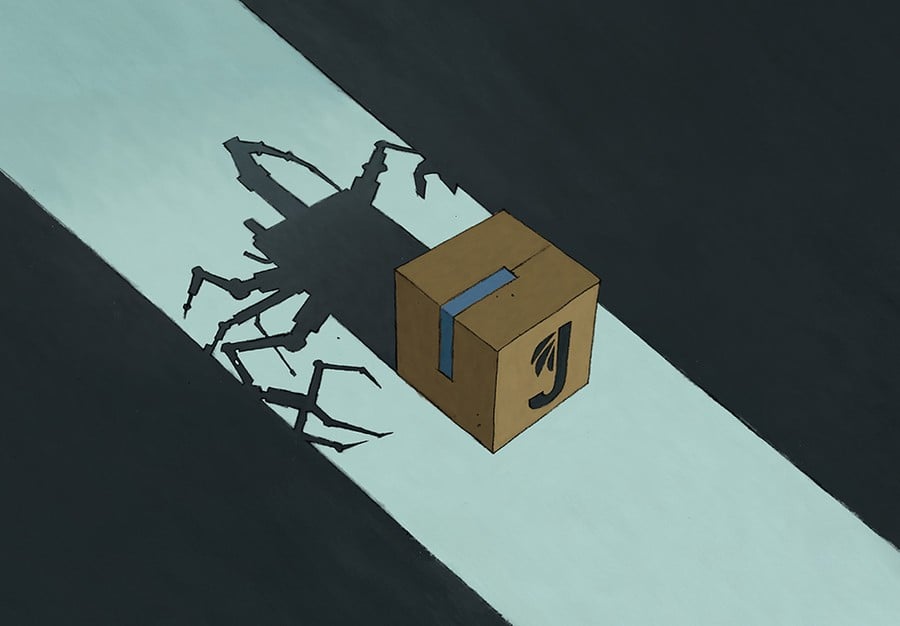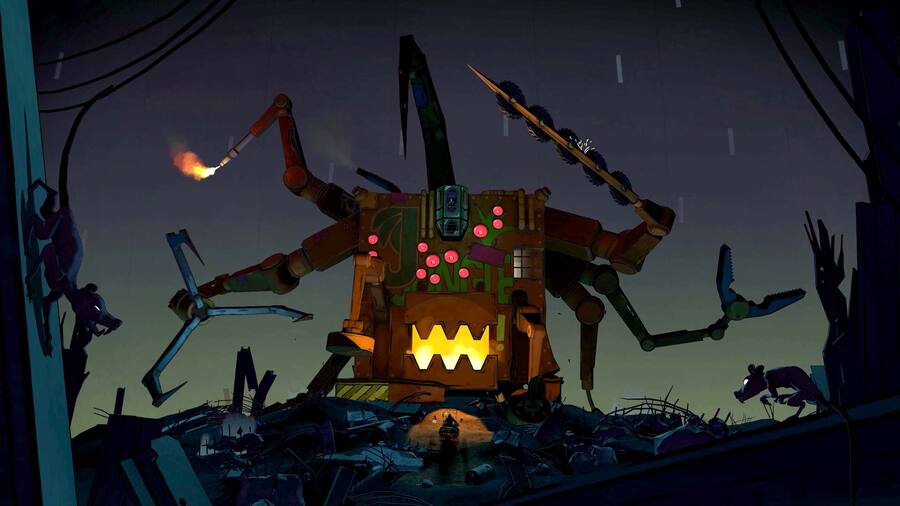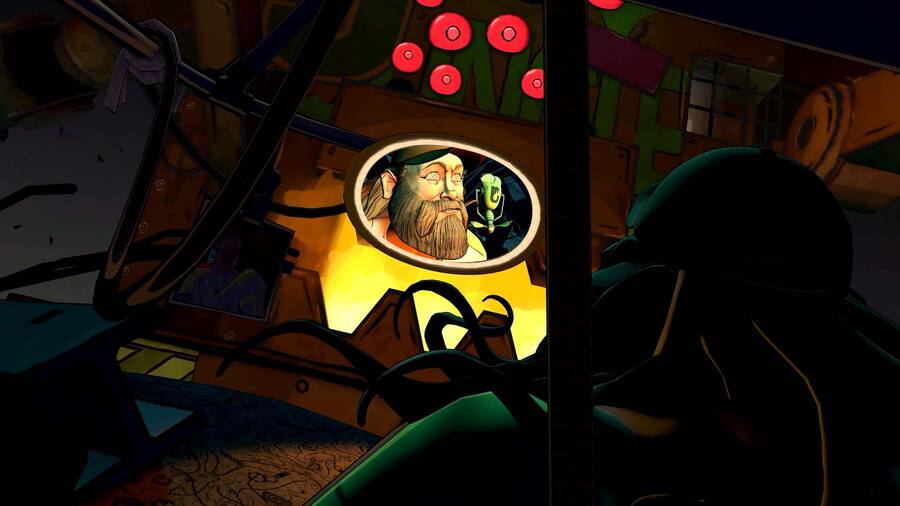
Recently, publisher Wired Productions unveiled its own ‘Direct’ in which it revealed a sizeable number of games, five of which are coming to Nintendo Switch. One that caught the eye, in part because its teaser was also visually arresting and rather vague, was The Last Worker.
As a concept it's intriguing. The setting is clearly post-apocalyptic, with a worker shown to be surrounded by a dystopian environment and a fearful machine. The 'warehouse' setting that's been cited certainly brings to mind current day affairs around mega corporations like Amazon, with machines and automation increasingly phasing out workers. There's serious pedigree in the development team too, and having spoken to creative lead Jörg Tittel to learn more, it’s certainly left us eager to see what the title will bring to Nintendo’s system.
 Watch on YouTube
Watch on YouTubeSubscribe to Nintendo Life on YouTube841k
Tittel himself has enjoyed a career across the arts, from theatre to video games, to film, TV and most recently back to games. As co-founder of Oiffy he has producer credits across artistic mediums, and his fascination with creativity of all types goes back to a childhood that broke down walls from one artform to the next.
It’s interesting, for me as a kid born and raised in Brussels, I’m half German, half Polish. I’m like some weird Pokémon if you combine them together. I was in a particularly boring part of Belgium outside of Brussels, surrounded by farmland. So, video games very quickly became my thing, as was watching countless movies. And my mom is a composer, she would write really beautiful film music, so being around musicians, artists and storytellers was something that I felt very much at home in, and games took me places, you know? I felt that especially when the graphics weren’t trying to mimic realism yet. So you have to read between the pixels. I love that. I could fill in those gaps, and I could add onto those pixels and add my own imagination on top, and I felt, wow, that is the future of storytelling.
Describing himself as a "SEGA kid" and seemingly with a knowledge of retro gaming that could see him hold his own against most enthusiasts, Tittel has a lifetime of blending mediums that itself comes with some amusing tales. Such as a childhood of earning pocket money by sending cheat codes to a German gaming magazine after seeing them in Famitsu months before those games were localised. Using that tale to then fund his study of theatre at New York University by getting into games journalism, before working at Treyarch on a Minority Report game and hustling to get an early look at the movie script.
Then there's a tale that goes to the very heart of Tittel's artistic outlook, and how it was met with resistance as he built his career in Los Angeles.
I’ve actually had meetings with people in places like Jerry Bruckheimer’s offices, and I was talking about: “I want to make movies and games together, and share assets across from one medium to the other, and develop them at the same time, have the same creative team, dream up the movie and the game at the same time.” I was actually inside Jerry “I call the Pentagon if I need extras” Bruckheimer’s office, accused of being a megalomaniac.

Storytelling, creativity and immersion are clearly at the heart of what Tittel wants to achieve with The Last Worker, and believes that the games industry has not only earned its place at the highest tables, but can set standards. Partly it's business, as the "film industry looks up at the game industry because the game industry makes more money", but also through what's being achieved creatively. Not always necessarily through games that strive so outwardly for narrative or emotional impact, or even gritty realism, but titles that can draw us in through sheer power of vision.
You have games like Celeste which will move you more than anything else, even though there are no realistic faces on screen. You play and you die a thousand times and you cry tears of frustration and joy, and also empathy, with this strange little pixel character. And that’s exciting, because now we have the Spielbergs of the game world right now, making, working with small teams and with distinct singular visions. I think we’ve arrived.
Video games can also attract multi-skilled teams, far from the days of 'bedroom coders' in the early '80s. In this case, Mike McMahon is on-board to drive the art style of the game, producing work that'll then be reimagined through development. McMahon is highly regarded in the graphic novel scene, with work in franchises such as Batman and Judge Dredd — among many others — on his CV.
The primary developer on the project is Wolf & Wood, a studio with an impressive history in VR development. Tittel immediately formed a strong connection with studio lead Ryan Bousfield, realising that the company's work in VR would be a boon as the project came together.
With Ryan I felt like: “he gets it. He just gets it.” And he’s brilliant because he made his first game completely by himself. A Chair In A Room was literally made by him sitting in a chair in a room. Actually, he has a standing desk so it’s a bit of a lie. Don’t believe everything on the packaging. But he made that sat, partially. The graphics, the music, the code, the shaders, everything in the game. And that got him the attention of John Carmack, and people at Oculus. He also had a Vive launch title with that, actually. So, with him, instantly, it was a meeting of minds, and he’s just an absolute joy to work with. His team is fantastic, he’s assembled a team of people who also very much like him are multi-talented, multi-skilled, everyone sort of knows how to dig in there and take ownership of their work, so it’s a real pleasure.
The other thing that it does also from a technological point of view, that you have to be extra lean, you can’t just throw everything at the screen because if that thing doesn’t run at a minimum of 72 frames a second per eyeball, people will vomit. So that’s a huge framerate. People are constantly going: “That game is running at a constant 30 frames a second. Docked at 60 frames…” you know? And you’re going: “Whoa, hey, well done” [Slow claps]. And that’s for a single screen.
Its fair to say that Switch owners have dealt with their fair share of sub-par ports, as developers struggle to grapple with the reality of working on a mobile chipset alongside relative console monsters like PS4 / Xbox One and now PS5 / Xbox Series X. Yet the teaser trailer is, we're assured, running in the game engine; more importantly, the first platform the game is being optimised for is the Oculus Quest. That matters because it is an untethered VR system, so it is essentially a mobile device. With the developers making a game and engine that'll run at a high framerate on a mobile chipset for VR, that'll make the transition to Nintendo Switch easier.
Besides all of that, Tittel's creative drive to steer clear from realism enables the game to look its best across platforms, whether 4K on a TV on a new console or on the more humble Switch screen.
It’s a great way of working because we’re not going to have to downscale or do some sort of port where suddenly you add fog and everything runs like a dog. Which happened to some games when they moved to Switch of course, which I won’t mention.
I mean, take a look at Monster Hunter and take a look at Breath Of The Wild, there are so many games on Switch that look incredible. Again that takes me back to this thing about my childhood, reading between the pixels. I’m not interested in mimicking realism. We didn’t go for that. At the same time, what we are doing is we have super sophisticated shaders which make things look sort of hand-made and hand-painted style, because we have really taken Mick McMahon’s beautiful art and translated it to the screen, and it’s amazing to be fully immersed in that world, regardless of whether you’re wearing a headset or watching it on a flatscreen, so-to-speak.
Though his most recent gaming on Switch has been in Virtua Racing, Tittel has also emphasized that the development team is aware of what makes the system tick, looking to implement 'unique things that other systems don't have' in both docked and portable configurations.
Of course, the question of what the actual gameplay will be like in The Last Worker is important, but it's the part that's the biggest mystery. The teaser and the setting tell a small part of the story, though we were read out the Steam store page almost verbatim as a joke about how little they're ready to share yet. It's first-person, it's a narrative experience, it'll shoot for emotional impact but also comedy, it'll have an 'all-star' cast. The setting is clearly post-apocalyptic, but these are crumbs.
Ultimately, what we do have are a lot of strong ideas, which will hopefully coalesce into a unique game.
It has lots of gameplay and really cool mechanics, and is actually quite arcadey, and it’s quite involved, and there are puzzle elements, and then they will never feel like mini-games slapped together. It’s a game that will tie gameplay and narrative together, the theatricality of really truly good gameplay. With The Last Worker we have an incredible cast, and we’re announcing them later this summer. And truly extraordinary actors, and they’re doing amazing stuff. And we will be breaking some boundaries, I hope. It’s a proper game that you can play and really dig your heels into. And hopefully with a story that will truly move you and amuse you and entertain you. Yeah, make you laugh tons and also scare you quite a lot.
We’re not just working with Mick and really finding a way to make his art look authentic inside the game. But we’re also doing stuff with music which is beautiful, and we’ll be unveiling more about that when we show gameplay. We’re doing wonderful stuff with sound, truly immersive sound, and again the VR will inform the flat versions because in VR you have to have the sound that surrounds you everywhere. Everything will sound analogue and look analogue and look hand-made and look like it was made by people, so even though it is a dystopia that we are showing, it is one that you will hopefully love spending time inside of.
It’s not going to be a brown neon thing that everyone else is doing, which is fine, but I mean we’ve all watched Blade Runner now and Blade Runner has still done it better than any of the neon sort of sci-fi that we are watching now. And so, it’s going to be something else, and hopefully people like it.

Perhaps what's most encouraging, at this stage of teaser-only silence, is that the project is led by artists with broad experience from theatre, to film, to games and VR, and it's clearly an endeavour to bring the best of each area to the final game. Tittel talks about "designing the confines around the story, and the story around the confines", despite an 'epic-sized environment', and shunning modern trends for algorithms and procedural generation in favour of a carefully designed world; each pixel should matter.
The ultimate goal is to make its world worth your time; we think every gamer will appreciate the sentiment.
I don’t want to feel like you’re working when you’re playing our game. I don’t want to waste your time with it, because I think time is precious, and as we’ve all learned life is pretty short, or can be. When you are going to use people’s time, please immerse them into something that feels deliberate, where everything you see on the screen has had thought put into it. Because that’s what I want. I just want every single bit of the game to feel like it’s had thought put into it, because that’s the only thing that I can give back to the world. Sure I’ve spent years dreaming it up, and working with incredible people or whatever, but I want you to feel good in that, and I want you to then feedback to me and it’s like: “Dude. I saw this one thing that meant so much to me because…” That’s what I want. Those are the conversations I’m looking forward to.
We'd like to thank Jörg Tittel and Wired Productions for their time; you can follow updates on the game
@thelastworker and @newjorg, and also on the official website thelastworker.com along with wolfandwood.co.





Comments 13
First I've heard if this game, I'll have to look at this later and get more info.
Oh man, I actually had that Minority Report game on GameCube. It actually was really fun although I haven’t played it since about 2004 so who knows if it’s aged well.
@Poodlestargenerica National Treasure is a national treasure.
Is this guy Peter Molyneux 2?
Edit: some parts of Minority Report were actually quite good! But the rest… heh. I still remember that part where you had to jump over some instant kill flames while the camera would get stuck in a pipe or something.
@PosterBoy I legitimately remember that part. Up there with the gears section in Prince of Persia Sands of Time and the sand bird in Sunshine as moments that ruined my childhood 😂
Wow, he sounds really up himself, sorry. It's so odd, because reading that reminded me of Peter Molyneux (over enthused empty rhetoric), and then I saw that @PosterBoy had already commented on that. Hopefully this guy can back up his hyperbolic words, but man that was painful to read. 🙁
He seems to have a good team around him and to build a game with occulus quest and switch in mind before ps5 and xbox series x is the best way for switch owner to have a game that runs well but in the end it’s the gameplay and the fun to play this game that will be used to judge if it’s good or just another dreamer bargain bin game.
@PosterBoy Hey! Your comment made me chuckle so I couldn't resist falling down this rabbit hole.
I interviewed Peter a couple of times back when I used to write for Edge's US sister mag Next Gen and the Official Dreamcast Magazine. In one interview in an E3 backroom, he announced to me there would be a female playable character in the first FABLE while the game's creators, Dene and Simon, looked at each other, aghast. Let's just hope it hasn't rubbed off, eh?
Yes, the MINORITY REPORT game was pretty awful.
Hope you'll enjoy THE LAST WORKER when it comes out.
Pointless trailer for the last worker shows nothing about what kind of game it is. Trailers without gameplay show a serious lack of understanding about videogames and marketing them.
I totally understand that politics get in the way of a lot of things. That being said, I can't get behind people that exploit others for their own gain. Go humanity!
Removed - discussing moderation
Shout out to Thomas for consistently putting out great articles for years. This website has been apart of my two websites I visit on a daily basis since 2013 when I was 15 years old. Thomas has always been a great writer that stood out to me and helped form my Nintendo related opinions throughout the years.
Keep up the great work guys. Nintendo Life for life. Still have my Nintendo life hoodie my mom get me for Christmas one year.
@michellelynn0976 @SuperZeldaFun it would be unfair for us to comment on other users accounts status in public, therefore all moderation issues are discussed in private. Please use the contact form if you wish to discuss further.
Show Comments
Leave A Comment
Hold on there, you need to login to post a comment...